Abstract
Based on various sources, according to which non-verbal communication is a form of expression through body language, one can say that physical education is one of the fields in which the relevance of this type of communication is a sine qua non condition in interpersonal relationships. Non-verbal communication contributes to the promotion of an active education, based on collaboration, on stimulating the common interests and promoting interdependence, interrelations between the participants in this process. The research started from the idea that using interpersonal communication in high-school education, one could stimulate a quality instructiveeducational process. Research hypothesis By knowing how to approach, during the physical education lesson, the forms and functions of non-verbal communication, one can make improving interventions, in the sense of capitalizing on them, for the benefit of the high-school instructive process. The research consisted of a sociological approach, using an organized inquiry on a target group of 50 pupils from the Mangalia Economic College, county of Constanţa. As a result of this sociological intervention, it can be said that during the communication process of certain implicit contents, such as the motor content that is specific to the school instructive-educational process, the role played by non-verbal forms is very important.
Keywords: Non-verbal communicationsociological approachhigh-schoolphysical education lesson
Introduction
According to Cerghit I. (2008), the teaching process, from the perspective of multiple
representations, presupposes action, information, interaction, communication and sociocentric systems
based on social interaction. The lesson, as principal means of organization and development of the
educational process, represents the framework in which there is an interaction between the factors of
the instructive-educational process: teacher-pupil. The effectiveness of the interactive methods is
ensured by the teachers' communication skills, their performance level that ensures the effectiveness of
the transmission and reception of the message. The diversity of the people communicating demands
from the teacher rhetorical and even persuasive skills.
(http://www.smc.roedu.ro/index_htm_files/suport%20de%20curs2.pdf)
Interpersonal communication implies the presence of three successive elements: purpose,
psychosocial means, and effects of communication. The real communicative behaviors can have a
verbal, non-verbal, para-verbal dominant, or they can be mix. No matter the way, all means have as
essential trait an exchange of significations, functioning only based on those generalizing cognitive
elements perceived by the people communicating.
Current communication theories (Hall & Knapp, 2013) identify in the non-verbal ones the
"kinesics," a name for the body language that includes body movements, the facial expressions ("facial
kinesics"), and regard ("oculesics"). Physical aspect, artifacts, and olfactory signals are considered also
separate categories of non-verbal communication, even if it is known that people transmit signals
simultaneously through multiple channels, which is why the integrative approach of this type of
communication is necessary (Chelcea, Ivan, & Chelcea, 2005).
Most researchers accept a classification resulted from the combination of the message transmission
codes and environments. Thus, J. Ruesch and W. Kess (1956, p. 205) associate non-verbal
communication with three categories: sign language, including gestures; action language, including
body movement in various activities; object language, incorporating the disposition of objects in space,
for their usage.
R. P. Harrison (1974) divides this type of communication into four categories: performance codes
associated with body movements, facial expressions, regard, touch and vocal activity; spatial-temporal
codes, referring to messages resulted from the combined use of space and time; artifact codes, used in
messages received from objects, and mediator codes referring to the special effects between emitter and
receiver.
D. G. Leathers (2007) identified the following non-verbal communication channels: facial expressions,
eye movement, posture, proxemics, physical aspect, suprasegmentals, such as intonation, tone, voice
volume, and skin touch. According to M. L. Knapp (2010), the field of non-verbal communication includes:
the way we regard, hear (tone of voice), smell, move (gestures, posture, regard, facial expressions, body
touch, and proximity), and how the human interactions affect the environment and vice versa.
The functions of non-verbal communication, according to P. Ekman (2015) are: repetition,
substitution - replacing the verbal messages, completion - collaborating to the transmission of verbal
messages, for a better decoding, accentuation/moderation - emphasizing the verbal messages,
amplifying or diminishing what has been said, and contradiction - transmitting signals that are in
opposition to the verbal messages.
Based on various sources, according to which non-verbal communication is a form of expression
through "body language," one can say that physical education is one of the fields in which the
relevance of this type of communication is a sine qua non condition in interpersonal relationships.
Body language communication represents the messages that are not expressed through words and that
can be decoded, creating meaning. (Dobrescu, 2006, p. 23). Non-verbal communication contributes to
the promotion of an active education, based on collaboration, on stimulating the common interests and
promoting interdependence, interrelations between the participants in this process.
Material & Methods
The research started from the idea that using interpersonal communication in high-school education,
one could stimulate a quality instructive-educational process. The theme was chosen based on the
conviction that physical education is one of the fields in which expressiveness and relevance of
expression through "body language" in the teacher-pupil relationships plays an important role during
the lesson and in making the educational process more effective.
Research hypothesis By knowing how to approach, during the physical education lesson, the forms
and functions of non-verbal communication, one can make improving interventions, in the sense of
capitalizing on them, for the benefit of the high-school instructive process.
The research consisted of a sociological approach, using an organized inquiry in the academic year
2014 –2015 on a target group of 50 pupils from the Mangalia Economic College, county of Constanţa.
The questionnaire comprised 12 items with open and prefigured answers, specifically designed for
young people of high-school age. The following research methods were used: the bibliographical
documentation, the observation, the inquiry, the statistical-mathematical method, and the graphical
representation method.
The perceptions identified for some of the items were assessed by grouping the questions addressed
to the subjects in 5 categories, according to the importance that each subject gave it. The normative
assessments led to certain value judgments and seeing the subjects' opinions through the prism of the
categories of assertions, identified and assessed on a scale from 1 to 5 for each item.
Results and Discussions
The first items of the questionnaire highlighted the fact that all inquired subjects (100%) believe
communication to be indispensable for the instructive process during the physical education lesson,
while 59% recognize it as a sine qua non in the teacher-pupil relationship, 21% - in the pupil-pupil
relationship, 11% - the teacher-parents relationship, and 9% emphasize the importance of the
relationship between specialized teachers and their colleagues (Figure
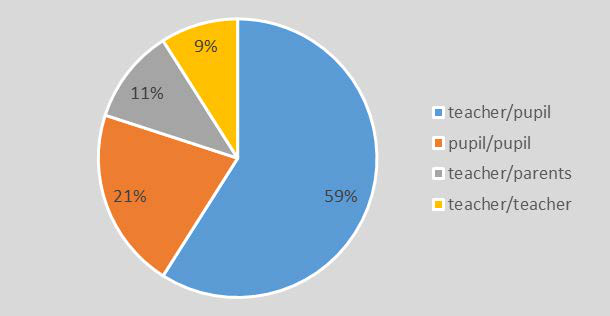
In the next section of questions, most respondents (92%) said that during the physical education
lesson there is a good communication in the teacher-pupils relationship. Of these subjects, 85.95%
consider non-verbal communication as being the most useful and most often encountered in the
structural part of the lesson, for consolidating the motor skills.
52.05% of the subjects said the most important role played by non-verbal communication during
the lesson is associated with the verbal indications, 21.25% highlighted only the role of communication
through body language, 18.35% supported the value of verbal messages and explanations (verbal
communication), and only 8.35% of the subjects believed that vocal traits that accompany words
(paraverbal) are more useful (Figure
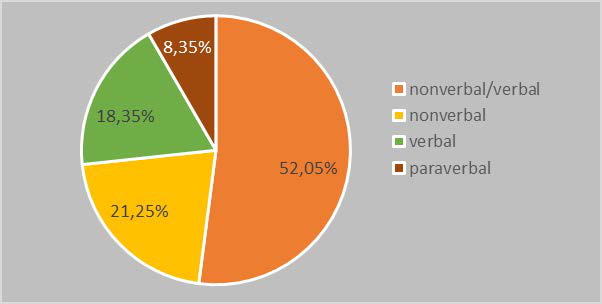
Based on the functions identified in the professional literature (Ekman, 2015) that non-verbal
communication performs in relation to the other communication forms, 52% of the subjects highlighted
its role of support for the verbal communication, of doubling the verbal message through
17% of the subjects considered non-verbal communication important for a better decoding of the verbal
messages (
(
communication, amplifying or diminishing what has been said (Figure
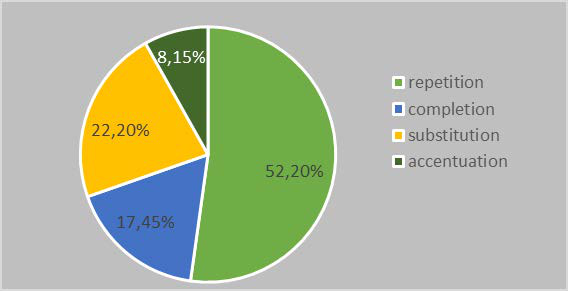
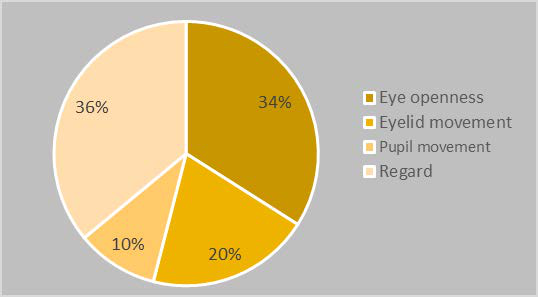
The questionnaire also emphasized the components of facial expressiveness as means of non-verbal
communication, which, in the high-school pupils' perception, constitute important elements for
transmitting messages - the openness degree of the eyes (34%); eyelid movement (20%); pupil
movement (10%), and type of regard (36%). (Fig. 4)
Through another item, the elements of communication through facial movements have been
identified, and the subjects highlighted their importance in the teaching process as follows: frowning
(36%), nose wrinkling (24%), eyebrow lifting (22%), lip tightening (18%). (Fig. 5)
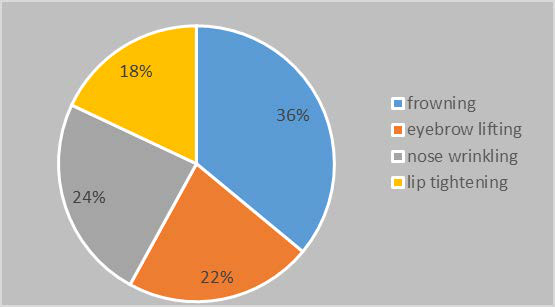
Of the non-verbal communication alternatives between teacher and pupil, the 5 means identified
from the professional literature were: posture, movement, gestures, facial expression, and look (exterior
appearance). Based on the statistical evaluations, the first place is taken by body movement, with an
average of 4.82 points, and the second place, by gestures that are specific to body expression in
physical education, with an average of 4.74 points.
These results are supported in both cases by a maximum value of 5 points, and a minimum value of
4.33 and 2.66 points, respectively. The third place is taken by posture, with an average of 4.45 points, a
maximum value of 4.66 points and a minimum value of 3.33 points. Less recognized are the influences
of facial expression and look (3.70 points) in the communication relationship between teacher and
athlete. (Fig. 6).
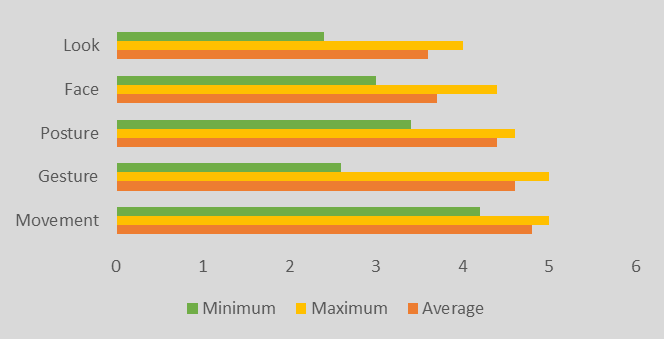
Starting from the capitalization directions for non-verbal communication, the results obtained for
the group of influence on the knowledge - self-knowledge process turn out to be in the top of the
subjects' choices, recording an average value of 4.80 points, a maximum value of 5 points, and a
minimum value of 4.30 points. One can say that the subjects are aware of the special role the body
language plays in increasing one's ability to internalize the specific sports training motor content.
The second place in the subjects' options is taken by the influence on the assessment - self-
assessment, with an average value of 4.60 points, a maximum value of 4.80 points, and a minimum
value of 3.80 points, which proves that, according to the subjects' answers, the effects of the studied
means on increasing the ability to assess a correct performance are recognized.
The third position is occupied by the direction feedback, which leads to the correct learning of the
technical components, assessed with an average value of 3.50 points, a maximum value of 4.20 points,
and a minimum value of 3.20 points.
The next category is the one regarding the correction-prevention, in the sense of forming the correct
automatisms, with an average of 3.30 points, a minimum value of 2.50 points, and a maximum value of
3.80 points. The last group of non-verbal communication influences, as perceived by the subjects, is the
one favoring the teacher-pupil relation, with an average of 2.80 points, a maximum value of 3 points,
and a minimum value of 2 points, envisaging the synchronization tendencies between the emitter and
the receiver. (Fig. 7).
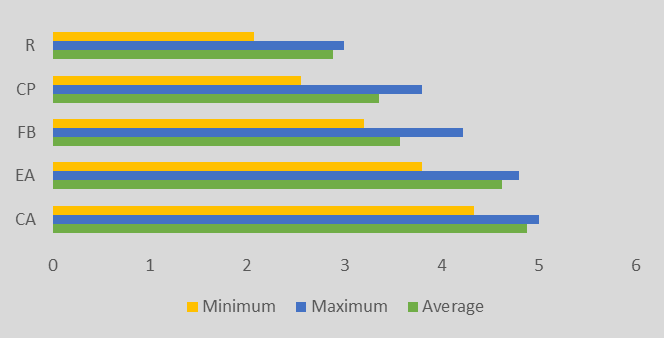
Conclusions
Based on the results recorded during this study conducted on high-school subjects, the following
conclusions can be drawn:
As a result of this sociological intervention, it can be said that during the communication process of
certain implicit contents, such as the motor content that is specific to the school instructive-educational
process, the role played by non-verbal forms is very important.
The body language communication is perceived by most respondents, the messages transmitted this
way facilitating a useful dialog between the teacher and the pupil.
A dominant form of expressing in the physical education lesson is represented by body movements
as "an expression of energy and information through posture, movement and indices", a psycho-
somatic connection (body-soul) through which feelings and emotions are expressed.
The teacher and the pupil must know and use the types of non-verbal communication as best as
possible, according to the goals of the instructive process, taking into consideration the techniques
identified in this study.
The identification of the subjects' perception regarding the importance of non-verbal
communication can influence the result of the instructive process and, implicitly, can lead to the
achievement the goals of the curricula and of the physical education lesson.
These results highlight the importance of using non-verbal communication compared to the other
two types, para-verbal and verbal, while during the instructive process the teacher and the pupil must
master and use opportunistically and harmoniously all the communication techniques, for an increased
effectiveness of the transmission of new knowledge and motor skills.
The gestures of illustration and the facial expressing are other landmarks of the existence of non-
verbal communication perceived by the students in the instructional process.
The variety of the non-verbal communication types can provide the solution for various stages of
the instructive-educational process in pre-university institutions, especially in high-school, as was
proven by this study.
In order to verify the ways in which this form of communication can be capitalized, in the sense of
improving the instructive process, this research can be followed by an applicative intervention.
References
- Cerghit, I. (2008). Sisteme de instruire alternative si complementare. Bucharest: Polirom, 400p.
- Chelcea, S., Ivan, L., & Chelcea, A. (2005). Comunicarea non-verbală: gesturile și postura. Bucureşti: Editura: Comunicare.ro, Romania.
- Dobrescu, T. (2006). Dimensiuni ale comunicării prin limbajul corpului. Iaşi: Tehnopress, 169 p.
- Ekman, P., Friesen, W.V. (2015). Unmasking the Face: A Guide to Recognizing Emotions From Facial Expressions. Cambridge: Malor Books, USA.
- Hall, J.A., & Knapp, M.L. (Eds.) (2013). Handbooks of communication science: Vol. 2: Non-verbal communication. Berlin: De Gruyter Mouton.
- Harrison, R.P. (1974). Beyond words: An introduction to non-verbal communication. Englewood Cliffs, NJ: Prentice-Hall.
- Knapp, M. L., & Daly, J. A. (2010). Interpersonal communication. 4 vol., Sage benchmarks in communication. London: Sag.
- Leathers, D.G. (2007). Successful Non-verbal Communication; Principles and Applications. Warszawa: Wydawnictwo Naukowe PWN, Poland.
- Ruesch, J., Kess, W. (1956). Non-verbal Communication: Notes on the Visual Perception of Human Relations. University of California Press, Berkeley.
- http://www.smc.roedu.ro/index_htm_files/suport%20de%20curs2.pdf, Strategii de success în învăţământul preuniversitar, 1.05.2016.
Copyright information

This work is licensed under a Creative Commons Attribution-NonCommercial-NoDerivatives 4.0 International License.
About this article
Publication Date
04 October 2016
Article Doi
eBook ISBN
978-1-80296-014-3
Publisher
Future Academy
Volume
15
Print ISBN (optional)
-
Edition Number
1st Edition
Pages
1-1115
Subjects
Communication, communication studies, social interaction, moral purpose of education, social purpose of education
Cite this article as:
Dobrescu, T. (2016). Non-Verbal Teacher-Pupil Communication in the High-School Physical Education Lesson. In A. Sandu, T. Ciulei, & A. Frunza (Eds.), Logos Universality Mentality Education Novelty, vol 15. European Proceedings of Social and Behavioural Sciences (pp. 287-294). Future Academy. https://doi.org/10.15405/epsbs.2016.09.37

